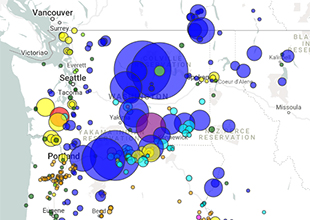
Electricity does more than keep the lights on in the Pacific Northwest. It literally powers our economy. The absence or presence of an adequate electricity supply can either curtail or facilitate economic growth. In the worst extreme, an inadequate electricity supply can affect public health and safety, as in a blackout. Fortunately, such events are rare and when they do happen are most often caused by a disruption in the delivery of electricity (transmission lines), not the supply. However, there have been times – during extreme cold spells or heat waves – when the supply has been tenuous.
Adequacy refers to having sufficient resources to serve loads. In determining adequacy, the Council uses sophisticated computer programs (such as GENESYS) that simulate the hourly operation of the power system over many different futures. Each future is simulated under a different set of unknown parameters, such as water supply, temperature, wind and solar generation and thermal resource performance.
Historically in the Pacific Northwest, the biggest risk for power system adequacy was having a bad water year coincide with high loads. That is no longer the case. Planning for the future grid is becoming more complex with the changing resource mix, increased load growth from electrification, periods of extreme weather, and additional uncertainties.
To better address these challenges, in FY 2023 the Council’s Power Division staff adopted a new, more sophisticated way to test whether the region’s power grid has adequate resources by using multiple metrics. The Council was among the first power planners in the U.S. to move to a multiple metric approach.
The Council’s previous adequacy metric of Loss of Load Probability (LOLP) focused on identifying the probability of a year with one or more simulated shortfalls from modeling that tested a range of hydropower, load, and wind conditions. The LOLP metric was effective for a power system heavily reliant on hydropower, thermal plants, and energy efficiency, where generation uncertainty was minimal and revolved around the coincidence of high loads and low water.
The Council evaluates shortfalls as a signal for needing emergency measures, such as a utility buying amounts of power from wholesale markets that are above market-import caps to meet peak demand. A multi-metric adequacy framework provides insights into the frequency, duration, and magnitude of potential shortfall events. An adequate system means all metrics stay within their respective thresholds.
The previous LOLP approach didn’t offer insights into how large the shortfall would be, how long it would last, or what month or season it would occur in.
With a multi-metric approach, it is now possible to fully understand the shape and size of adequacy issues. This is a major advancement in helping the Council and the region plan for needed solutions.
The process to develop the multi-metric adequacy standard featured working with utilities and energy providers, including Bonneville Power Administration, throughout the region. Staff consulted with regional organizations such as the Western Power Pool, Pacific Northwest Utilities Conference Committee, Pacific Northwest Generating Cooperative, and the Columbia River Inter-Tribal Fish Commission. Finally, staff interviewed representatives and technical staff from public utilities commissions in Idaho, Oregon, and Washington.
Multiple metrics
Following an extensive public engagement and research process, the Council adopted the following adequacy metrics in FY 2023:
- Frequency – Loss of load events (LOLEV) is used to prevent overly frequent use of emergency measures.
The next three metrics are designed to protect against extreme shortfall events 39 out of 40 years. It means adequacy events do not last too long or have large magnitudes.
- Duration – Value at Risk sets a limit to protect against prolonged use of emergency measures. This helps to capture the risk of a summer heatwave or a winter storm.
- Magnitude – Peak Value at Risk protects against large magnitude emergency measure use.
- Magnitude – Energy Value at Risk protect against large aggregate use of emergency measures during a year.
The Council continues to refine these metrics by developing provisional thresholds, and will further evaluate them in advance of the next power plan process.
See the Resource Adequacy Advisory Committee for all current work.





